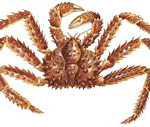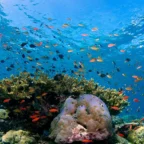
Boreogadus saida
The Arctic or polar cod (Boreogadus saida) is distributed throughout the ecoregion and occurs in coastal habitats during both summer and winter months. It is able to tolerate a wide range of temperatures, saline levels and turbidities. It is found further north than any other fish species. Arctic cod spawns only once during its life cycle. When newly hatched the larvae feed on copepods larvae (very small crustacea) and eggs. As they grow, they graduate to krill and other crustaceans, then to small fish.
Adult cod feed mainly on fish such as capelin and herring and can grow to 40cm in length, though will typically be around 25cm. Although this species has a similar appearance to other southerly cod species, its slender body, deeply forked tail, projecting mouth and small barbel on its chin easily differentiate it.
The colouring is brown along the back, with fine dark points. The sides and stomach are silvery; the fins almost black, with a pale streak at the base. The jaws are of almost equal length, with the lower jaw perhaps slightly longer. There are three dorsal (back) and two anal fins, each distinctly separate from each other. The one Pectoral fin reaches beyond end of first dorsal fin; and a pelvic fin has a slightly elongated ray. The body tapers toward the tail.
In the arctic, fish are generally less colourful than their southern counterparts, with the reduced sunlight making visual cues less important.
These fish are a key component of the arctic community’s food chain as they are the primary food source for narwhals, belugas, ringed seals and a number of sea birds. Other predators such as Atlantic cod, Arctic char, Greenland halibut and Atlantic salmon also prey on Arctic cod. They are the principle consumers of plankton in the upper water column, unlike their cousins the Atlantic cod, which feed on the bottom.









Social Profiles